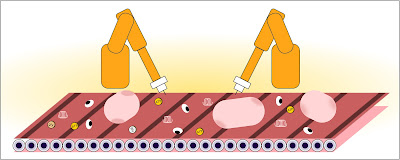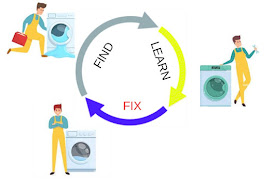Session April 2022: “Economic theory and models”
Talks “Economics methodologies” by Karl Schlag and “Cybersocialism” by Jan Philipp Dapprich
Our April 2022 Forum session was devoted to economics and its possible connections to cell models. Karl Schlag, from the Department of Economics at the University of Vienna, introduced basic concepts used in economic theory and modeling approaches, many of which may find some future application to model cellular behaviors. Then, Jan Philipp Dapprich, from the Philosophy Department of the Free University Berlin, told us about planned economies and presented an economic model that closely resembles Flux Balance Analysis models.
Karl gave a comprehensive overview of the main mathematical concepts and some central theorems in economics. He first distinguished between a normative and a positive perspective. An individual’s preferences and choices are described by a personal utility function, a function whose existence is guaranteed under very general conditions by the von Neumann–Morgenstern theorem: a subject assesses a personal (subjective) distribution of uncertain events, each outcome receives a cardinal number (utility), and the best choice maximizes subjective expected utility. The guiding idea is that preferences between unlikely, but more desirable events and likely, but less desirable events can be directly compared. In economics, the concept of utility is not necessarily based on monetary gain, but can also represent ethical preferences and can be used to explain risk-averse and risk-loving behaviors. For groups, utilities can be aggregated in different ways, where Pareto efficiency is a major requirement in the theories: the fact that no individual could be better off unless at the expense of others. From an individual’s perspective, utility can be maximized under certainty or under uncertainty (that is, maximizing the subjectively expected utility). With a set of several utility functions, a Nash equilibrium may be obtained. Karl further told us about how to design rules that govern interactions, with the aim to obtain Pareto efficient outcomes, and to design optimal rules (e.g. in the case of second-price auctions). Another big topic in economics is how to deal with time, e.g. how to weigh future utilities. An important principle is the principle of time-consistent decisions, implying that an optimal plan must also remain optimal in the future unless conditions are changing or new information becomes available. Another conceptual trick is to treat all subjective unknowns as the outcomes of some probabilistic “choice of nature. To deal with complexity, the cost of a complex strategy can be incorporated in one’s utility function. To summarize, economics deals with scarce resources, analyses values and interactions, and often assumes equilibrium states (where it is often assumed - or shown under simple assumptions - that markets lead to Pareto-efficient outcomes).
In his answers to questions by the audience, Karl elaborated on the definition of utility and on the use of dynamic models in economics. He clarified the notion of utility (and the equivalent term “payoff”, which is often used in evolutionary game theory): in economics utility is not always expressed in money, but describes how one thinks about money. This may also include any other motivations for an individual’s choices such as ethical convictions. Next, we discussed the types of dynamics in economic models. Differently from biology, modeling in economics focuses mostly on equilibria: standard economics, following the Chicago school, assumes that the economic world can be explained in terms of equilibrium states. There are parametric equilibrium models of equilibrium that work very well to interpret data and to predict how people make purchases and how prices should be set, but these models are based on very questionable assumptions. Trajectories of inflation or the outbreak of a war are not taken into account with such models. Another limitation of the model is that we use current or past demand to predict the future, you don’t know exactly how consumers react to the change of the prices. In the dynamic case, systems are described using evolutionary game theory and replicator dynamics.
After this general overview by Karl, Jan Philipp focused on a very specific approach, linear programming, which was developed in the context of planned economies and is also the basis of Flux Balance Analysis, a method heavily used in cell modeling. In his talk on “Cybersocialism”, Jan Philipp discussed socialist economics and presented his work on the adjustment of prices in planned economies, proposing a feedback mechanism that would match supply and demand. He started by explaining how a socialist economy was first envisioned by Marx and Engels and later implemented in the USSR. A main challenge was to match production and consumption in different industries, like the steel and car industries. Leonid Kantorovich first developed linear programming in the USSR to plan a balanced and optimal socialist economy: linear optimisation was used to obtain plan that were both physically feasible - matching all supplies and demands - and supposedly optimal. Asking which production output should be maximized, Kantorovich proposed to fix the proportions of certain end products - then, any of them could be used as the objective. The USSR was not fully able to handle its planned economy; Jan Philipp explained later developments by Paul Cockshott, who later worked on improved methods for planned economies and who applied the harmony algorithm to tackle very large linear programming problems.
Next, Jan Philipp discussed how public goods are to be distributed. He presented Marx's theoretical concept of “labor vouchers”, which would credit workers for their labor time and could be redeemed for products out of socialized production; this would mean that the price of a product would correspond to the socially necessary labor time done to produce the product. Other socialist economists have proposed to use “market clearing prices”, aimed to match demand and supply in order to avoid overproduction and shortages. Finally, Jan Philipp outlined the utopian concept of a planned economy in which prices would be adapted to consumers’ behavior, creating a feedback loop between production volume and consumer demand, with the aim to ensure that production meets the consumers’ needs [1]. His idea is to use opportunity costs or shadow prices (the overall maximal gain obtained from a hypothetical, free extra supply of a material) to adjust the price of this material. An advantage of this choice of prices over labor values is that extra cost factors, such as penalties on carbon emissions, can be easily taken into account. Different versions of automatic control loops by which this feedback can be implemented were described.
The discussion following Jan Philipp’s talk dwelled upon how uncertainty can be taken into account and the simple on-off controllers considered so far could be replaced by methods from robust and model predictive control. In the following general discussion, we discussed whether Jan Philipp’s suggestion would be actually feasibly and whether cells could be seen as “socialist beings”, both with respect to division of labor in cell communities and to their intracellular resource allocation strategies.
In our follow-up discussion with Jan Philipp one week later, we came back to the similarities between Flux Balance Analysis and his linear programming approach. We discussed suitable objective functions for cells (such as growth rate and yield) and the fact that cellular biomass composition is supposed to be known in some models, while it emerges as a model prediction in others. Next we returned to the question of cooperation or competition between cells, noting that cellular subsystems and cells in a multicellular body are assumed to be “cooperative”, while microbes and higher organisms, between each other, are typically assumed to compete. Finally, we discussed temporal behavior that involves a temporal build-up of resources, such as multi-year plans in planned economies (e.g. in the Feldman theory of growth) or storage in cells. In biology, the solutions predicted from simple models (e.g. discrete switches in “bang-bang strategies”) are often not observed in cells, probably because many side constraints, objectives or downsides of strategies are simply ignored in models (for example, the fact that storage makes an organism more attractive for predators).
In summary, our Forum session on economics showed close analogies between linear programming approaches in economics and cell biology. We also saw that the concepts and methods of economics are much broader than the “economic” tools exploited in Systems Biology, leaving a lot of avenues to be explored. We will certainly come back to these ideas in future Forum sessions!
Reference
[1] Jan Philipp Dapprich (2022): Optimal Planning with Consumer Feedback: A simulation of a socialist economy. Review of Political Economy, DOI: 10.1080/09538259.2021.2005367
Thanks to
- Speakers: Karl Schlag (University of Vienna) and Jan Philipp Dapprich (Free University Berlin)
- Panel: The speakers and Stefan Schuster (University Jena)
- Organizer: Wolfram Liebermeister (INRAE)
- Bloggers: Carlos Xosé Sequeiros, Christian Fernández, Giulia Slaviero, Hamza Faquir, Niccolò Totis, Wolfram Liebermeister



Comments
Post a Comment